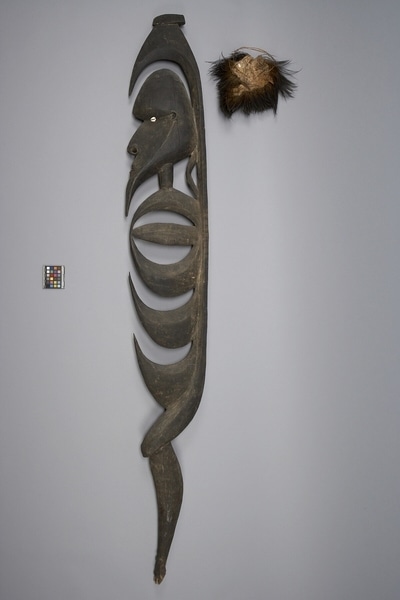Hook Item Number: Ie397 a-b from the MOA: University of British Columbia



Description
Carved wooden yipwon (hook figure). Downward pointed hook shaped in the form of a human figure (part a). The figure is wearing a triangular shaped, flat headdress. The eyes are inlayed with cowrie shells, the nose projects slightly with a hollow septum, the mouth is small and incised while the chin is long and pointed. The body of the figure consists of opposed hooks encircling a central protrusion and two upward facing hooks appearing like human ribs. The frame hooks or back of the figure curves in slightly then ends with one human leg with a small foot and carved toes. The hook is stained black. Covering part of the figure’s head is a cassowary feather wig (part b) with skin that has been has been pierced in two places and fibre strands tied through.
History Of Use
Yipwon, or kamanggabi, are kept in the men's house and are the property and responsibility of the senior clan. They may be consulted in the planning of war. Their answer is delivered by a shaman believed to be possessed by the spirit of the kamanggabi. Small offerings of food may be made to ensure their benevolence and the prosperity of the group and village. The figures may be surrounded by decorations such as leaves, feathers and substances for successful hunting or fertile crops.
Item History
- Made in East Sepik, Papua New Guinea
- Owned by William H. Birmingham before March 21, 1980
- Received from William H. Birmingham (Seller) and Museum of Anthropology Donations Fund (Funding source) on March 21, 1980
What
- Name
- Hook
- Identification Number
- Ie397 a-b
- Type of Item
- hook
- Material
- cowrie shell, cassowary feather, cassowary skin, wood and pigment
- Manufacturing Technique
- carved, cut, tied, stained, inlaid and pierced
- Part A
- height 210.9 cm, width 28.7 cm, depth 9.1 cm
- Part B
- height 27.3 cm, width 35.2 cm, depth 19.3 cm
Who
- Culture
- Arambak
- Previous Owner
- William H. Birmingham
- Received from
- William H. Birmingham (Seller) and Museum of Anthropology Donations Fund (Funding source)
Where
- Holding Institution
- MOA: University of British Columbia
- Made in
- East Sepik, Papua New Guinea
When
- Ownership Date
- before March 21, 1980
- Acquisition Date
- on March 21, 1980
Other
- Condition
- good
- Current Location
- Case 69
- Accession Number
- 0620/0014